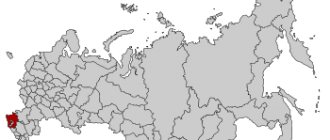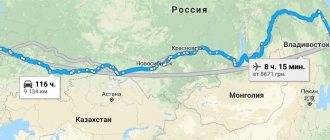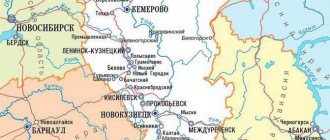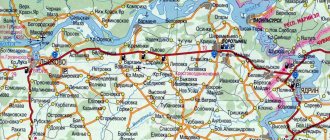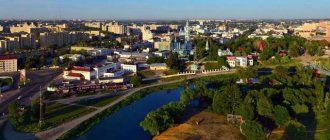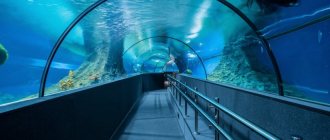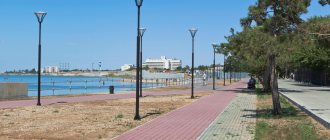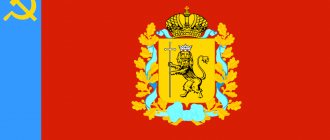Which regions of Russia belong to the Far North?
When establishing the boundaries of the Far North, the Government was guided by the geographical location, the influence of climate on people and equipment, and the costs of production . As a result, a List of regions of the Far North and localities equated to regions of the Far North was created for the purpose of providing state guarantees and compensation for persons working and living in these areas and localities. It identifies the subjects, regions and settlements of the Russian Federation, whose residents can count on “northern allowances” .
The regions of the Far North are highlighted in the darkest color. Photo: commons.wikimedia.org
What benefits are provided for residents of the Far North?
Those who work in the regions of the Far North and in territories equivalent to them can count on a significant increase in wages, which consists of a regional coefficient and a percentage increase. The size of the coefficient will be different for different regions (for example, in Chukotka it can reach 100% of the salary).
Also, employees of these territories are entitled to additional paid leave (from 16 to 24 days), compensation for expenses on vacation tickets . All these issues are regulated by RF Law N 4520-1.
Of course, in the article we will not list all the settlements of the Far North, but will focus only on a few large and popular cities in this area. Data on salaries was taken from the website “trud.com”, data on the cost of apartments - from “naydidom.com”.
Kazan
Eastern and Western traditions are intertwined here so tightly that hardly anyone would dare to say which of them predominates. This is felt everywhere and is perhaps best illustrated by the Temple of All Religions located in the center of the city. The same applies to medieval buildings, among which there are beautiful mosques, a leaning tower, and Orthodox cathedrals. However, Kazan is not limited to religious buildings, demonstrating truly Western elegance and well-groomedness.
Arkhangelsk
Arkhangelsk is located in the North-West of Russia and belongs to lands equated to the Far North. Founded in 1584, almost 345 thousand people live in it. The climate here is subarctic, with long winters and short, cool summers. However, it cannot be said that terrible frosts reign here: the average temperature for January is 12.4 °C below zero . The economy is centered around the timber, fishing and fish processing industries. Therefore, production workers will be the most in demand here.
At the beginning of the year, a ranking of cities by standard of living was published. Arkhangelsk took 75th place out of 85 possible.
The wooden city of Arkhangelsk was built in just “one year.” PHOTO: pixabay.com
Arkhangelsk in numbers 2022:
- Population - 344,927 people.
- The average salary is 38,525 rubles.
- The average cost of a one-room apartment is RUB 2,480,000.
What is our life? A game!
Ivan the Terrible, being one of the most controversial Russian tsars, amazed his contemporaries not only with his methods of governing the state, but also with his hobbies. It is known that the sovereign was seriously interested in astrology, compiled maps of the starry sky and believed that the heavenly bodies were capable of predicting a person’s fate. Another activity that brought genuine joy to the king was playing chess.
The death of Ivan the Terrible at chess. Artist Petr Tsepalin - Source: pinterest.ru
It is curious that back in the first half of the 16th century they tried to ban chess in Rus', and the associates of Ivan IV, Metropolitan Macarius and the author of Domostroi, Archpriest Sylvester, advocated for this. The latter dubbed the game “demonic” entertainment and sent curses on everyone who sat down at the chessboard at least once in their life. However, even the threats of his confessor did not stop Ivan Vasilyevich. The Tsar not only enjoyed playing chess himself, but also invited the main guardsman, Malyuta Skuratov, as well as Ivan Glinsky and Boris Godunov, who, however, could not surpass Ivan the Terrible in such an intellectual game, to share the game with him.
According to one version of the death of Ivan IV, the autocrat died playing chess. According to the Englishman Horsey, who left memories of Muscovy, on that fateful day of March 28, 1584, Ivan Vasilyevich could not place the king’s piece on the board - it kept falling. When the king completely lost consciousness, the remaining figures fell to the floor with a roar. Isn't this an omen of the Time of Troubles?
Severodvinsk
And this city in the Arkhangelsk region already belongs to the regions of the Far North . It was founded less than a hundred years ago, in 1936, as a shipbuilding village near the mouth of the Northern Dvina River. Now about 180 thousand people live there, and the life of the city still revolves around shipbuilding. The city-forming enterprises of Severodvinsk are JSC PO Northern Machine-Building Enterprise and OJSC ". They are engaged in the construction and repair of nuclear submarines, civilian ships and surface ships.
The former names of Severodvinsk are the village of Sudostroy and the city of Molotovsk. PHOTO: cdn.ptisidiastima.com
Severodvinsk in numbers 2022:
- Population - 180,806 people.
- The average salary is 38,109 rubles.
- The average cost of a one-room apartment is RUB 2,788,750.
Story
Historically, the settlement was founded in the 13th century: it is from this era that there are descriptions of the small fishing village of Wogram. Only later is it said about the settlement of Pil, or Pillau, which was divided into two different parts. This city is named based on the Prussian origin meaning "pilz", which means "fortress" in Russian. Over time, the population of Pillau increased and the place became a major transport hub. Pillau was renamed Baltiysk on November 27, 1946.
Norilsk
Norilsk is a city in the Krasnoyarsk Territory , the construction of which began in 1935 with the construction of the Norilsk Mining and Metallurgical Combine. It was built by Gulag prisoners. In 1953, the settlement received city status, and is currently considered the northernmost settlement in the world with a population of more than 150,000 people .
The weather in Norilsk is harsh: the average temperature in January is -27 C (the minimum recorded temperature is -64 C), and in July - only +14.3 C. And city residents also have to adapt to the Polar Night. PHOTO: bigenc.ru
Norilsk is the center of non-ferrous metallurgy. Metals such as palladium, osmium, platinum, etc. are mined here. Naturally, the active work of metallurgical enterprises has affected the environment - Norilsk is one of the 10 most polluted places on the planet.
The Norilsk plant produces 35% of the world's palladium.
Norilsk in numbers 2022:
- Population - 182,701 people.
- Average salary - 51,046 rubles.
- The average cost of a one-room apartment is RUB 2,127,699.
Climate
The climate of the city is temperate, maritime, and at times temperate continental. It is most suitable for citizens suffering from pathologies of the respiratory tract and cardiovascular system. However, the city is often threatened by storms.
Winter here is mild, the average temperature does not fall below -10 Celsius, but in summer the water does not heat up enough - only up to 17-18 degrees. However, in 2008, the water heated up to 24 degrees, and in the winter of 2009, ice covered 100 meters from the coastline.
Murmansk
Murmansk is the largest city located above the Arctic Circle. It was built on the coast of the Kola Bay of the Barents Sea. The population is about 283 thousand people. Murmansk is first and foremost a port; it was founded for these purposes in 1916. The climate here is moderate, and severe frosts are rare. The polar night lasts from December 2 to January 11, and the polar day lasts from May 22 to July 22 . The main sectors of the economy of Murmansk are fishing and fish processing, as well as ship repair, shipping, metalworking and the food industry .
In Murmansk you can observe the Northern Lights. PHOTO: unsplash.com
Murmansk in numbers 2022:
- Population - 282,851 people.
- Average salary - 43,213 rubles.
- The average cost of a one-room apartment is RUB 3,191,585.
Monchegorsk
Another city in the Murmansk region, located beyond the Arctic Circle. Monchegorsk is a single-industry town whose life revolves around a mining and metallurgical plant.
A single-industry town is a settlement founded at a city-forming enterprise to provide production with labor resources.
When the plant was first built, it was assumed that these lands were rich in copper and nickel. However, the deposit turned out to be very small, so now the city-forming enterprise of Monchegorsk is processing raw materials from Norilsk.
Monchegorsk is located on the slope of a mountain range on the shores of lakes Imandra and Lumbolka. Photo by: Lihgra Adventure
Monchegorsk is very small - a little more than 40,000 people. The environmental situation here is unfavorable due to emissions from the plant. However, with the modernization of production, the situation is slowly but surely improving.
Monchegorsk in numbers 2022:
- Population - 40,675 people.
- The average salary is 42,272 rubles.
- The average cost of a one-room apartment is RUB 1,419,365.
Vorkuta
A city in the Komi Republic, founded in 1936 for the sake of coal mining. Vorkuta has a unique climate: on the one hand, the frost-free period here is on average only 70 days (frosts are possible even in summer), and on the other hand, annual temperature fluctuations are small and the average temperature for January is 19 °C below zero . There is a short Polar Night - 11 days and a Polar Day - 46 days .
Vorkuta is described as a city with poor infrastructure but high salaries. PHOTO: wikiway.com
Now Vorkuta, in fact, is a single-industry town, closely connected with its mines.
Vorkuta in numbers 2022:
- Population - 52,292 people.
- Average salary - 44,861 rubles.
- The average cost of a one-room apartment is RUB 1,424,371.
Website of Mikhail Kozhaev
On May 19, 2016, it became known about the decision of the Verkhovna Rada of Independent Ukraine to rename the city of Dnepropetrovsk to Dnepr. The renaming was initiated by the city council at the end of 2015 as part of the decommunization of the names of Ukrainian cities. The fact is that the city was renamed in honor of the Soviet party and statesman Grigory Petrovsky (1878 - 1958), and not in honor of the Apostle Peter, as might have been expected. And now the capital of the Dnepropetrovsk region of Ukraine is the city of Dnieper.
A similar situation in Russia is associated with Yekaterinburg and St. Petersburg, which, having returned to their former names, remained the centers of the Sverdlovsk and Leningrad regions, respectively. But that's not even what we're talking about. Today I just wanted to remember and find out the former names of Russian cities. Because many former names are not only unheard of, but may even seem paradoxical. For example, what is the name of Stavropol-on-Volga today? Don't remember? Because how else would you know the old name of Togliatti, if you were either not born and lived there, or had relatives there, or were a Wasserman from Russian geography. For everyone else - this article.
Cities with a population of more than 500 thousand people
To determine the order of indicating cities whose names have changed during Russian history, the principle of population decrease was chosen - from the largest to the smallest. To do this, it turned out to be sufficient to use a list of Russian cities with the corresponding rank, for example, in the Wikipedia table. It seems enough to limit ourselves to cities with a population of more than 500 thousand people, and say a few words about the rest separately. So.
| City | Former names | Notes |
| Saint Petersburg | Petrograd (1914 – 1924) Leningrad (1924 – 1991) | Yes, Peter’s child was imprinted in the history of the Great Patriotic War with the sad phrase “siege of Leningrad.” The former capital of the Russian Empire, Petrograd was renamed in honor of the pseudonym of the leader of the world revolution. |
| Ekaterinburg | Sverdlovsk (1924 – 1991) | Yakov Mikhailovich Sverdlov, together with Lenin, sanctioned the execution of the royal family in Yekaterinburg... |
| Nizhny Novgorod | Gorky (1932 – 1990) | Yes, if not for another pseudonym, this time of the writer Alexei Maksimovich Peshkov, the cars of the local plant would be called not GAZ, but NNAZ... |
| Samara | Kuibyshev (1935 – 1991) | Valerian Vladimirovich Kuibyshev is another associate of Lenin in the cause of the revolution. Born in Omsk, died in Moscow, but in 1917 he established Soviet power in Samara. |
| Permian | Molotov (1940 – 1957) | Vyacheslav Mikhailovich Molotov is an ardent revolutionary and Soviet politician. The city of Perm was renamed Molotov in honor of the 50th anniversary of the then chairman of the Council of People's Commissars of the USSR. It is interesting that until 1957, two more cities bore his name in the version “Molotovsk” - Severodvinsk and Nolinsk. |
| Volgograd | Tsaritsyn (1589 – 1925) Stalingrad (1925 – 1961) | The title of Hero City was awarded to Stalingrad in 1965, when the city lost the name of Stalin after the leader’s cult of personality was debunked. But the Battle of Stalingrad played a decisive role in the Great Victory. |
| Krasnodar | Ekaterinodar (1793 – 1920) | Catherine's gift to the Black Sea Cossack army. |
| Tolyatti | Stavropol / Stavropol-on-Volga (1737 – 1964) | Everything is simple: on the Volga - so as not to be confused with the Azov Stavropol, and Togliatti - in honor of the leader of the Italian Communist Party Palmiro Togliatti, who died in 1964. |
| Ulyanovsk | Sinbirsk (1648 – 1780) Simbirsk (1780 – 1924) | Named in honor of the real name of Vladimir Ilyich Lenin, who was born here and died in 1924. |
| Makhachkala | Petrovskoye (1844 – 1857) Petrovsk (1857 – 1921) | During the Persian campaign of 1722, the camp of Peter I’s troops was located here. It was renamed in honor of the Avar revolutionary, Bolshevik and Dagestan political figure Makhach Dakhadayev. Makhach, by the way, is his pseudonym. |
| Ryazan | Pereyaslavl-Ryazan (1095 – 1778) | Yes, Ryazan has been called Ryazan for three times less time compared to its former name. |
| Naberezhnye Chelny | Brezhnev (1982 – 1988) | Yes, the Brezhnev era was short and stagnant. |
Cities with a population of less than 500 thousand people
Yes, it would be completely wrong to focus only on large cities. After all, population is one thing, and proud names are another. It is difficult to imagine the current article without recalling Grebenshchikov’s line “This train flies like an apostolic rank on the way from Kalinin to Tver” and without indicating that from 1931 to 1990 Tver bore the name of the “All-Russian elder” Mikhail Ivanovich Kalinin.
However, we can limit ourselves to simple mentions of how certain Russian cities were previously called. So:
Kirov – Vyatka – Khlynov
Kaliningrad – Twangste – Königsberg
Stavropol – Stavropol-Caucasian – Voroshilovsk
Sevastopol – Akhtiar
Ivanovo – Ivanovo-Voznesensk
Kurgan – Tsarevo Settlement – Kurganskaya Sloboda
Vladikavkaz - Ordzhonikidze (yes, if the city had been left named in honor of Grigory Nikolaevich Ordzhonikidze, it would not have been Vlaikavkaz, Ordzhonikidze’s “Alania” that would have been the Russian football champion in 1995)
Murmansk – Romanov-on-Murman
Yoshkar-Ola – Tsarevokokshaysk – Krasnokokshaysk
Syktyvkar – Ust-Sysolsk
Dzerzhinsk – Rastyapino
Veliky Novgorod – Novgorod
Engels – Pokrovskaya Sloboda – Pokrovsk
Yes, not only cities, but also entire countries and empires are insured against large-scale renaming. It is only important that the new names are chosen to suit your taste. Here is Tula, for example. As it was founded in 1146, it remains Tula today. Maybe it’s true what they say: whatever you call a ship, that’s how it will sail. This is especially true for such huge ships as cities.
To answering machine
| The meaning of the song BG Stella Maris | Stars in "Friends" | There are no such words in Russian |
Petrozavodsk
The capital of Karelia is located on the shores of Lake Onega. Although Petrozavodsk is equated to the regions of the Far North, the climate here is moderate. Winters are long but mild, and summers are cool. 20 streams and rivers flow through the city. Petrozavodsk is sometimes called the port of 5 seas, since through a system of rivers and canals it has access to the Baltic, White, Barents, Black and Caspian seas.
The sculptures on the embankment have recently become a symbol of the city. PHOTO: 64parallel.ru
Petrozavodsk has enterprises in the engineering, forestry, woodworking, food and light industries. In recent years, the tourism industry has been actively developing.
Petrozavodsk in numbers 2022:
- Population - 263,540 people.
- The average salary is 37,242 rubles.
- The average cost of a one-room apartment is RUB 2,677,741.
What to see in Baltiysk?
Due to the fact that the city is tied to the sea, all entertainment events here are, in any case, associated with the Baltic Sea or the local strait.
The region is adored by lovers of military themes and fortresses. The most recognizable symbol of Baltiysk is the lighthouse designed by the famous German architect Karl Schinkel in 1913. However, there are a number of other symbols of the Soviet era, including the monument to Peter the Great (installed in 1998), the cavalry of the “Empress Elizaveta Petrovna” and the Museum of the Baltic Sea Fleet.
The city is also symbolized by the image of a woman holding a baby in her arms; it ended up on the shores of the Kaliningrad Bay back in Soviet times. Today this monument has become a symbol of the joy and happiness of meetings of families and relatives with sailors who are on duty at sea.
Be that as it may, a trip to Baltiysk will be noted for its versatility and full of interest. Every year, Baltiysk, in addition to the well-known parade in honor of Navy Day, also holds the All-Russian Bards Song Festival. During the peak tourist season, it has become a tradition to organize large Open Air style parties, bartender competitions and competitions among the country's leading DJs. All these components attract and will attract hundreds and thousands of tourists from various parts of the country and foreign countries to Baltiysk, the westernmost city of the Russian Federation.
Kostomuksha
A city in Karelia, built to serve the Karelian mining and processing plant. Currently it is home to about 30,000 people. Kostomuksha is located just 35 kilometers from the Russian-Finnish border in taiga lands with a temperate climate. It has relatively warm, snowy winters and cold, rainy summers. The city lives on iron ore mining and wood processing.
The city has tourism potential, because on its territory is located the ancient Karelian village of Voknavolok, where the world famous epic “Kalevala” was created. PHOTO: i.pinimg.com
Kostomuksha in numbers 2022:
- Population - 29,778 people.
- The average salary is 43,340 rubles.
- The average cost of a one-room apartment is RUB 2,476,402.
Features of the nature of North-West Russia
About 30% of the region's territory is located in the forest zone of Russia. Forest cover gradually decreases as you move from northeast to southwest. Most of the Northwestern economic region is covered with coniferous forests. The southwestern part is in the mixed forest zone.
The nature of the surface of the territory
The Northwestern region is located on the edge of the East European Plain. It is characterized by flat terrain, which was strongly influenced by glaciations. Glaciers brought large masses of loose material - moraine. This led to the formation of glacial ridges and hills. After the ice melted, the depressions in the earth's crust were filled with water, and lakes were formed. After the departure of the glaciers, numerous irregularities, on the contrary, turned into plains through which rivers now flow.
The soils in the North-Western region are podzolic; there are also swampy and low-humus soils. For agricultural work, many soils require large amounts of fertilizer.
Climate
The climate of the main part of the North-Western economic region is temperate continental. In January, average temperatures are recorded at -9 degrees. The average July temperature is +16 degrees. In the east, precipitation ranges from 500 to 600 mm. On the Baltic coast - up to 1600 mm.
The climate of the Kaliningrad region is transitional - from marine to temperate continental. Winters here are quite mild, and thaws occur frequently. The snow cover is unstable. In January the average temperature is -2...-4 degrees, in July +17 degrees. It often rains here, and in winter there is sleet, so the area is humid and cloudy. There are only 60-65 sunny days per year. Winds are frequent. 750-940 mm of precipitation falls annually.
Inland waters
The Northwestern region is rich in water resources. There are about 7 thousand lakes within its borders. The largest lakes in the North-Western economic region:
- Ladozhskoe – its area is 17.7 thousand square kilometers. This is one of the largest fresh water reservoirs in Russia (second only to Baikal);
- Onega - area 9.7 thousand square kilometers;
- Lakes Peipus and Pskov - total area of 3.6 thousand square kilometers;
- Ilmen - an area of 1 thousand square kilometers.
Of the major rivers in the region, it is worth highlighting the Neva, Volkhov, and Svir. Despite the abundance of water resources in the Northwestern economic region, they are distributed extremely unevenly. Most are concentrated in the northern part of the region. Closer to the south, the number of water bodies decreases noticeably, which limits the development of water-intensive industries.
Natural resources
In the North-West of Russia, mineral reserves are insignificant. Fuel and energy resources are almost completely absent. Oil, natural gas and coal are imported from neighboring regions. In the Novgorod region there are deposits of peat, which is used as fuel at local power plants, as well as in the agricultural industry.
Large reserves of fusible clays are concentrated in the North-Western economic region. The largest deposits are located in the Novgorod region - in the Borovichi and Novgorod districts. 11 deposits of refractory clays have been discovered, the largest of which are located in the Borovichi-Lyubytinsky mining region. Limestones are mined in the Leningrad (Slantsevskoye, Pikalevskoye and Volkhovskoye deposits) and Novgorod (Okulovskoye deposit) regions. Limestones serve as raw materials for the chemical, aluminum, pulp and paper industries, as well as for agriculture. There is a large bauxite deposit near Boksitogorsk. They are used in the aluminum industry. Phosphorites are mined at the Kingisepp phosphate ore deposit (Leningrad Region), some of which is exported. Also in the North-Western region, deposits of marble, granite, quartz, mineral paints, sand, and manganese have been discovered.
The recreational resources of North-West Russia are unique. A large number of historical monuments, natural landscapes, architectural attractions, and tourist areas are concentrated here, many of which are the hallmark of the region.
The northernmost city in Russia
Pevek is the northernmost city in Russia. It got its name from the hill, which the locals called “peekinei”. It means "thick mountain". It is very difficult to get to Pevek; the only option is to fly from Moscow, Magadan or Anadyr.
Until 2022, the city was so closed that even Russians could only enter it with special permission.
In the 90s, the population of Pevek decreased three times . At the end of the 1980s it was 13 thousand people, and by 2000 about 4 thousand remained in the city. It remains so to this day.
The northernmost city in Russia. Photo: commons.wikimedia.org
Subscribe to Migranta Rus: Yandex News.
Moscow
Moscow has long been a real metropolis of the modern world, like Constantinople or London. Here you can find all the signs of a Western lifestyle, from wide avenues, monumental buildings, nightclubs and fashionable restaurants to ancient monuments. The main thing is to choose a suitable route, since there are so many attractions in the Russian capital that it is easy to get confused among them.
